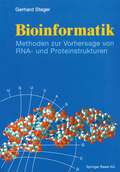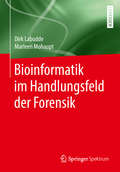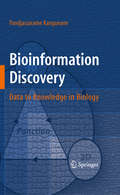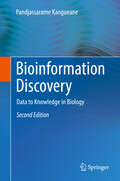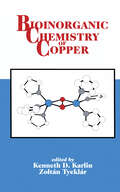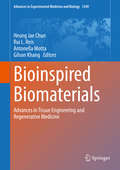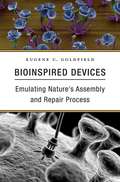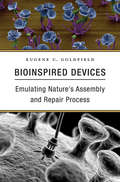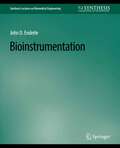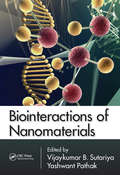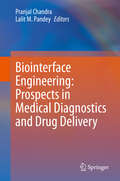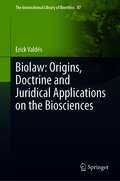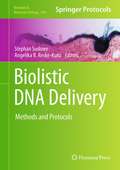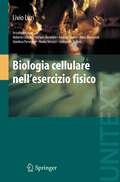- Table View
- List View
Bioinformatik: Methoden zur Vorhersage von RNA- und Proteinstrukturen
by Gerhard StegerMit Hilfe der Bioinformatik können ermittelte DNA-, RNA- oder Aminosäuresequenzen hinsichtlich Struktur und Funktion schnell eingeschätzt werden; das spart Kosten und Zeit bei weiterführenden Experimenten im Labor. Das vorliegende Buch gliedert sich in einen RNA- und einen Protein-Teil. Je ein Kapitel führt das biologische Thema der Strukturvorhersage inklusive biophysikalischer Grundlagen der Vorhersagemethoden ein. Folgekapitel gehen auf die informationstechnischen Methoden mit einem möglichst kurzen Beispiel ein, stellen den meist komplizierteren Algorithmus zur Lösung des biologischen Problems vor und diskutieren zum Abschluss mindestens eine Implementation und damit erzielbare Ergebnisse anhand eines biologischen Beispiels. Das Buch ist gleichermassen für Biologen und Informatiker relevant, da es sowohl einen Überblick über die aktuellen Möglichkeiten der Strukturvorhersage gibt als auch den Einsatz von unterschiedlichsten informationstechnischen Methoden in der Biologie demonstriert.
Bioinformatik im Handlungsfeld der Forensik
by Dirk Labudde Marleen MohauptDieses Lehrbuch soll Studierenden den Einstieg in die Gebiete der Forensik und Bioinformatik gleichermaßen erleichtern. Anhand eines fiktiven Falls, der sich durch das gesamte Buch zieht, wird die Bioinformatik und deren Grundlagen in das Gebiet der Forensik übertragen. Der Fall deckt eine Vielzahl an biologischen Spuren, sowie deren klassische Analyse ab und definiert neue Handlungsfelder in der Bioinformatik und Forensik.In diesem Werk werden verschiedenste Bereiche der Forensik bioinformatisch aufbereitet: Genetischer Fingerabdruck: Auswertung auf Sequenz- statt auf Profilebene Fingerspuren: krankheitsbedingte bzw. genetisch bedingte VeränderungenUntersuchungen zum Phänotyp einer PersonGrundlegende Erkenntnisse zur Wundheilung sowie zur Blutalterung in- und ex-vivo Dieses Buch zeigt die Notwendigkeit auf, die Forensik um weitere Wissensbereiche zu ergänzen und gibt Einblicke in eine Vielzahl moderner Themen der Forensik wie zum Beispiel Populationsgenetik; Wundaltersbestimmung, Daktyloskopie oder Menschen ohne Fingerabdruck.Vor allem Studierende aus den Lebenswissenschaften sowie Dozierende ebendieser Fachrichtung, werden durch dieses Lehrbuch spannende Einblicke in topaktuelle Fragestellungen bekommen.
Bioinformatik Interaktiv: Grundlagen, Algorithmen, Anwendungen
by Rainer Merkl Stephan WaackThe second edition of this successful textbook, completely revised and largely expanded. In particular the section on the analysis of genome data is covered in much greater depth and chapters added on machine learning, Bayesian networks, protein and enzyme designs as well as the evaluation of microarrays. Furthermore an attractive website with supplementary material and problems is available: WWW.WILEY-VCH.DE/HOME/BIOINFORMATIK
Bioinformatik Interaktiv: Grundlagen, Algorithmen, Anwendungen
by Rainer Merkl Stephan WaackThe second edition of this successful textbook, completely revised and largely expanded. In particular the section on the analysis of genome data is covered in much greater depth and chapters added on machine learning, Bayesian networks, protein and enzyme designs as well as the evaluation of microarrays. Furthermore an attractive website with supplementary material and problems is available: WWW.WILEY-VCH.DE/HOME/BIOINFORMATIK
Bioinformation: Problemlösungen für die Wissensgesellschaft (Technik, Wirtschaft und Politik #38)
by Castulus Kolo Thomas Christaller Ernst PöppelBioinformation Discovery: Data to Knowledge in Biology
by Pandjassarame KangueaneBioinformation Discovery illustrates the power of biological data in knowledge discovery. It describes biological data types and representations with examples for creating a workflow in Bioinformation discovery. The concepts in knowledge discovery from data are illustrated using line diagrams. The principles and concepts in knowledge discovery are used for the development of prediction models for simulations of biological reactions and events. Advanced topics in molecular evolution and cellular & molecular biology are addressed using Bioinformation gleaned through discovery. Each chapter contains approximately 10 exercises for practice. This will help students to expand their problem solving skills in Bioinformation Discovery. Each chapter concludes with a number of good problem sets to test mastery of the material.
Bioinformation Discovery: Data to Knowledge in Biology
by Pandjassarame KangueaneThis new edition continues to illustrate the power of biological data in knowledge discovery. It describes biological data types and representations with examples for creating a workflow in bioinformation discovery. The concepts in knowledge discovery from data are illustrated using line diagrams. The principles and concepts in knowledge discovery are used for the development of prediction models for simulations of biological reactions and events. Advanced topics in molecular evolution and cellular & molecular biology are addressed using bioinformation gleaned through discovery. Each chapter contains approximately 10 exercises for practice. This will help students to expand their problem solving skills in Bioinformation Discovery. In this new edition, there are three new chapters covering single nucleotide polymorphism, genes, proteins and disease, and protein functions driven by surface electrostatics.
Bioinorganic Chemistry of Copper
by K.D. Karlin Z. TyeklarBioinorganic Chemistry of Copper focuses on the vital role of copper ions in biology, especially as an essential metalloenzyme cofactor. The book is highly interdisciplinary in its approach--the outstanding list of contributors includes coordination chemists, biochemists, biophysicists, and molecular biologists. Chapters are grouped into major areas of research interest in inorganic copper chemistry, spectroscopy, oxygen chemistry, biochemistry, and molecular biology. The book also discusses basic research of great potential importance to pharmaceutical scientists. This book is based on the first Johns Hopkins University Copper Symposium, held in August 1992. Researchers in chemistry, biochemistry, molecular biology, and medicinal chemistry will find it to be an essential reference on its subject.
Bioinspired and Biomimetic Polymer Systems for Drug and Gene Delivery
by Zhongwei GuHere, front-line researchers in the booming field of nanobiotechnology describe the most promising approaches for bioinspired drug delivery, encompassing small molecule delivery, delivery of therapeutic proteins and gene delivery. The carriers surveyed include polymeric, proteinaceous and lipid systems on the nanoscale, with a focus on their adaptability for different cargoes and target tissues. Thanks to the broad coverage of carriers as well as cargoes discussed, every researcher in the field will find valuable information here.
Bioinspired and Biomimetic Polymer Systems for Drug and Gene Delivery
by Zhongwei GuHere, front-line researchers in the booming field of nanobiotechnology describe the most promising approaches for bioinspired drug delivery, encompassing small molecule delivery, delivery of therapeutic proteins and gene delivery. The carriers surveyed include polymeric, proteinaceous and lipid systems on the nanoscale, with a focus on their adaptability for different cargoes and target tissues. Thanks to the broad coverage of carriers as well as cargoes discussed, every researcher in the field will find valuable information here.
Bioinspired Approaches for Human-Centric Technologies
by Roberto CingolaniThe present book discusses topics related to research and development of materials and devices at nanoscale size and their respective application in medicine and biomedicine.The individual chapters give a detailed state of the art overview to the distinct topic. Apparently disconnected fields - life sciences, biomedicine, chemistry, physics, medicine and engineering - will be bridged with a highly interdisciplinary view onto each subject.
Bioinspired Biomaterials: Advances in Tissue Engineering and Regenerative Medicine (Advances in Experimental Medicine and Biology #1249)
by Rui L. Reis Heung Jae Chun Gilson Khang Antonella MottaThis book is the first of two volumes that together offer a comprehensive account of cutting-edge advances in the development of biomaterials for use within tissue engineering and regenerative medicine. Topics addressed in this volume, which is devoted to bioinspired biomaterials, range from novel biomaterials for regenerative medicine through to emerging enabling technologies with applications in, for example, drug delivery, maternal–fetal medicine, peripheral nerve repair and regeneration, and brain tumor therapy. New bioinspired hydrogels receive detailed attention in the book, and a further focus is the use of bioinspired biomaterials in the regulation of stem cell fate. Here the coverage includes the role of scaffolds in cartilage regeneration, the bioapplication of inorganic nanomaterials in tissue engineering, and guidance of cell migration to improve tissue regeneration. The authors are recognized experts in the interdisciplinary field of regenerative medicine and the book will be of value for all with an interest in regenerative medicine based on biomaterials.
Bioinspired Devices: Emulating Nature’s Assembly and Repair Process
by Eugene C. GoldfieldEugene Goldfield lays out principles of engineering found in the natural world, with a focus on how components of coordinated structures organize themselves into autonomous functional systems. This self-organizing capacity is one of many qualities which can be harnessed to design technologies that can interact seamlessly with human bodies.
Bioinspired Devices: Emulating Nature’s Assembly and Repair Process
by Eugene C. GoldfieldEugene Goldfield lays out principles of engineering found in the natural world, with a focus on how components of coordinated structures organize themselves into autonomous functional systems. This self-organizing capacity is one of many qualities which can be harnessed to design technologies that can interact seamlessly with human bodies.
Bioinstrumentation (Synthesis Lectures on Biomedical Engineering)
by John EnderleThis short book provides basic information about bioinstrumentation and electric circuit theory. Many biomedical instruments use a transducer or sensor to convert a signal created by the body into an electric signal. Our goal here is to develop expertise in electric circuit theory applied to bioinstrumentation. We begin with a description of variables used in circuit theory, charge, current, voltage, power and energy. Next, Kirchhoff's current and voltage laws are introduced, followed by resistance, simplifications of resistive circuits and voltage and current calculations. Circuit analysis techniques are then presented, followed by inductance and capacitance, and solutions of circuits using the differential equation method. Finally, the operational amplifier and time varying signals are introduced. This lecture is written for a student or researcher or engineer who has completed the first two years of an engineering program (i.e., 3 semesters of calculus and differential equations). A considerable effort has been made to develop the theory in a logical manner—developing special mathematical skills as needed. At the end of the short book is a wide selection of problems, ranging from simple to complex.
Biointeractions of Nanomaterials
by Vijaykumar B. Sutariya Yashwant PathakAn examination of the widespread application of nano materials in biology, medicine, and pharmaceuticals and the accompanying safety concerns, Bio-interactions of Nano Materials addresses the issues related to toxicity and safety of nano materials and nano systems. It covers the interactions in biological systems and presents various tools and meth
Biointerface Engineering: Prospects in Medical Diagnostics and Drug Delivery
by Pranjal Chandra Lalit M. PandeyThis book provides detailed information on the surface and surface chemistry of various biointerfaces for the understanding and development of biosensors, biocompatible devices, and drug delivery systems. It highlights the role of interfacial phenomena towards the behaviour of biomolecules on different surfaces and their significance in recent applications. The book also addresses various surface engineering techniques for the modification of biomaterials that are implemented for improving biocompatibility. It provides an updated scientific concept of various interactions of biological systems with surfaces/modified surfaces at the molecular and cellular level. The chapters include various in-vitro, in-vivo, ex-vivo models to illustrate various aspects of Biointerface Engineering. Finally, the book elucidates troubleshooting strategies and future prospects of Biointerface Engineering in Medical Diagnostics and Drug Delivery.
Bioisosteres in Medicinal Chemistry (Methods and Principles in Medicinal Chemistry #54)
by Raimund Mannhold Hugo Kubinyi Gerd FolkersWritten with the practicing medicinal chemist in mind, this is the first modern handbook to systematically address the topic of bioisosterism. As such, it provides a ready reference on the principles and methods of bioisosteric replacement as a key tool in preclinical drug development. The first part provides an overview of bioisosterism, classical bioisosteres and typical molecular interactions that need to be considered, while the second part describes a number of molecular databases as sources of bioisosteric identification and rationalization. The third part covers the four key methodologies for bioisostere identification and replacement: physicochemical properties, topology, shape, and overlays of protein-ligand crystal structures. In the final part, several real-world examples of bioisosterism in drug discovery projects are discussed. With its detailed descriptions of databases, methods and real-life case studies, this is tailor-made for busy industrial researchers with little time for reading, while remaining easily accessible to novice drug developers due to its systematic structure and introductory section.
Bioisosteres in Medicinal Chemistry (Methods and Principles in Medicinal Chemistry #54)
by Raimund Mannhold Hugo Kubinyi Gerd FolkersWritten with the practicing medicinal chemist in mind, this is the first modern handbook to systematically address the topic of bioisosterism. As such, it provides a ready reference on the principles and methods of bioisosteric replacement as a key tool in preclinical drug development. The first part provides an overview of bioisosterism, classical bioisosteres and typical molecular interactions that need to be considered, while the second part describes a number of molecular databases as sources of bioisosteric identification and rationalization. The third part covers the four key methodologies for bioisostere identification and replacement: physicochemical properties, topology, shape, and overlays of protein-ligand crystal structures. In the final part, several real-world examples of bioisosterism in drug discovery projects are discussed. With its detailed descriptions of databases, methods and real-life case studies, this is tailor-made for busy industrial researchers with little time for reading, while remaining easily accessible to novice drug developers due to its systematic structure and introductory section.
Biolaw: Origins, Doctrine and Juridical Applications on the Biosciences (The International Library of Bioethics #87)
by Erick ValdésThis book configures a consistent epistemology of biolaw that distinguishes itself from bioethics and from a mere set of international instruments on the regulation of biomedical practices. Such orthodox intellection has prevented biolaw from being understood as a new branch of law with legally binding force, which has certainly dwindled its epistemological density. Hence, this is a revolutionary book as it seeks to deconstruct the history of biolaw and its oblique epistemologies, which means not accepting perennial axioms, and not seeing paradigms where only anachronism and anomaly still exist. It is a book aimed at validity, but also at solidity because the truth of biolaw has never been told before. In that sense, it is also a revealing text. The book shapes biolaw as an independent and compelling branch of law, with a legally binding scope, which boosts the effectiveness of new deliberative models for legal sciences, as well as it utterly reinforces hermeneutical and epistemological approaches, in tune with the complexity of disturbing legal scenarios created by biomedical sciences’ latest applications. This work adeptly addresses the origins of the European biolaw and its connections with American bioethics. It also analyses different biolaw’s epistemologies historically developed both in Europe and in the United States, to finally offer a new conception of biolaw as a new branch of law, by exploring its theoretical and practical atmospheres to avoid muddle and uncertainty when applied in biomedical settings. This book is suitable for academics and students of biolaw, law, bioethics, and biomedical research, as well as for professionals in higher education institutions, courts, the biomedical industry, and pharmacological companies.
Biolistic DNA Delivery: Methods and Protocols (Methods in Molecular Biology #940)
by Stephan Sudowe and Angelika B. Reske-KunzBiolistic transfection represents a direct physical gene transfer approach in which nucleic acids are precipitated on biologically inert high-density microparticles (usually gold or tungsten) and delivered directly through cell walls and/or membranes into the nucleus of target cells by high-velocity acceleration using a ballistic device such as the gene gun. Biolistic DNA Delivery: Methods and Protocols provides a comprehensive collection of detailed protocols intended to provide the definitive practical guide for the novice as well as for the advanced gene transfer expert on how to introduce nucleic acids into eukaryotic cells using the biolistic technique. Split into six convenient sections, this detailed volume covers biolistic gene transfer into plants, nematodes, and mammalian cells, both in vitro and in vivo, as well as the use of gene gun-mediated DNA vaccination in various experimental animal models of human diseases, and the description of biolistic delivery of molecules other than nucleic acids. Written in the highly successful Methods in Molecular Biology™ series format, chapters include introductions to their respective topics, lists of the necessary materials and reagents, step-by-step, readily reproducible laboratory protocols, and tips on troubleshooting and avoiding known pitfalls. All-inclusive and cutting-edge, Biolistic DNA Delivery: Methods and Protocols brings together the knowledge and the experience of leading experts in the field of gene transfer in order to serve all researchers who wish to further our abilities in this vital field.
Biologia cellulare nell'esercizio fisico
by Livio LuziLa nascita delle Facoltà e dei Corsi di Laurea di Scienze Motorie, e la chiusura degli ISEF, hanno prodotto un radicale mutamento degli insegnamenti della nuova Facoltà Universitaria. In particolare, i percorsi di formazione degli insegnamenti forniti da Scienze Motorie, a seguito delle due riforme che si sono succedute nell’ultimo decennio, si sono notevolmente arricchiti di materie teoriche sia di base che applicate a problematiche del movimento umano. La Biologia Applicata è sicuramente tra i nuovi insegnamenti quello che più di altri caratterizza la differenza tra i corsi ISEF e le nuove classi di Laurea universitarie inerenti lo sport. A questo riguardo, esisteva quindi una lacuna formativa e comunicativa nel campo della Biologia Applicata che andava colmata con la preparazione di questo manuale che, senza la pretesa di essere esaustivo nel settore della Biologia, tratta in dettaglio gli argomenti di Biologia rilevanti per l’attuale percorso formativo didattico dello studente di Scienze Motorie, con particolare attenzione agli eventi endocellulari che determinano, regolano e modulano l’esercizio fisico. Oltre all’utilizzo da parte degli studenti di Scienze Motorie, per i quali questo libro è stato scritto, professionisti e operatori nel settore dello sport e del tempo libero possono trarre vantaggio dalla sua lettura. Il presente volume è frutto di un lavoro di équipe o, se si preferisce, dell’esperienza di una Scuola che da circa 30 anni si è occupata di ricerca nel settore del metabolismo, della endocrinologia e della fisiologia dello sport.
Biologic and Nanoarthroscopic Approaches in Sports Medicine
by Chad LavenderIn recent years, there have been a number of exciting advances in biologic and nanoarthroscopic approaches in sports medicine, giving the clinician even more options for safe and effective minimally invasive treatments for the active patient. This practical text presents these breakthrough techniques in detail and describes the authors' experiences and lessons learned.This book is broken into two main sections. The first section presents the history of the use of biologics in sports medicine and will have several chapters describing novel techniques using platelet-rich plasma (PRP) and bone marrow concentrate (BMC), all-inside allograft ACL reconstruction, minimally invasive quad tendon harvest with endoscopic closure, and cartilage transfer (ACT) using an autologous tissue collector, among others. The second section describes the history of arthroscopy and the most recent use of nanoarthroscopy, including several novel techniques utilizing the nanoscope, such as incisionless partial medial meniscectomy, synovectomy of the knee, and single incision approaches for the anterior labrum and rotator cuff.Practical and cutting edge, Biologic and Nanoarthroscopic Approaches in Sports Medicine is an exciting exploration of the most recent management approaches for both sports medicine and orthopedic surgeons.
Biologic and Systemic Agents in Dermatology
by Paul S. YamauchiWritten by leading experts in the field and designed for dermatologists and residents, this book includes evidence-based medicine that underscores the clinical data, as well as practical tips on how to use both biologic and systemic agents in the field of dermatology. In the past decade, there have been several groundbreaking advances in medical dermatology. Novel biologic and systemic agents have been developed to treat inflammatory disorders, including psoriasis and atopic dermatitis, as well as skin malignancies such as melanoma. Biologic and Systemic Agents in Dermatology encompasses these developments by describing the mechanism of action of these various agents and the clinical efficacy and safety to treating these respective disorders. The utilization of biologic and systemic agents in other dermatologic conditions, pharmacoeconomics, pharmacovigilance, and clinical trials outcomes are discussed as well as topics including tumor necrosis, conventional systemic agents for psoriatic disease, and oral agents for atopic dermatitis.
A Biologic Approach to Environmental Assessment and Epidemiology
by Thomas J. Smith David KriebelIn this book, Thomas J. Smith and David Kriebel assert that important advances in the quantification of environmental risks can only come through a true synthesis of the fields of environmental epidemiology and exposure assessment. They have built a common biologic model of exposure, physiologic response, and disease, a synthesis of the various existing models which serves to both simplify and improve the application of environmental epidemiology and exposure assessment to current and future environmental chemical risks.
